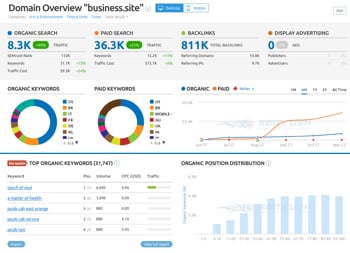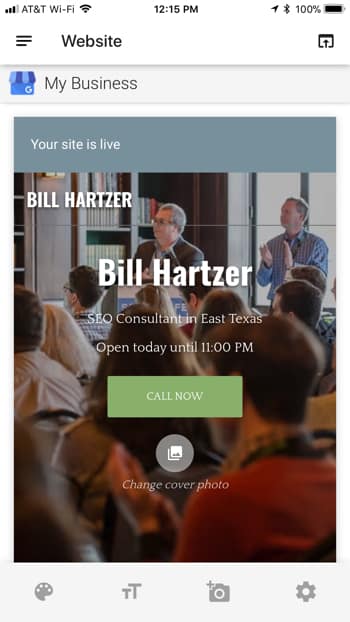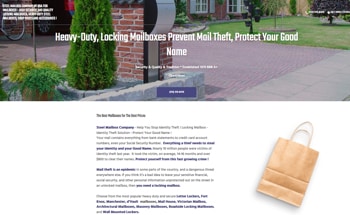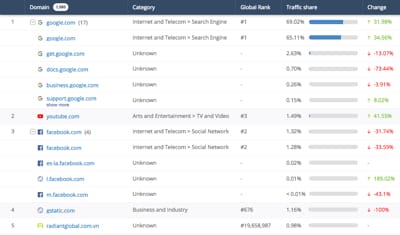
A while back, Google My Business launched a feature that allows verified local businesses to create their own website. Once logged in to Google My Business, you can use their interface to upload a header image, a title and headline, and text about your business. You can link out to other web pages, and a Google map is also embedded, so visitors can get directions to your business. Before publishing, you are asked to create a URL for your website, or order a custom domain name.
The default (free) URL of your Google My Business website is something like CompanyName.Business.Site. Google is using a .SITE TLD (Top Level Domain), specifically Business.Site, for the hundreds of thousands of GMB websites that are being created. Being curious about the usage of Business.Site, I took a deep dive into this domain name, how Google My Business websites are being built, and how these websites are ranking in Google’s own search engine. During this research, which ended up being large enough to be an extensive case study, I found quite a few interesting points worth noting:
- As of November 2017, Google is indexing over 900,000 Business.Site pages in their search index.
- Pages on Business.Site mainly rank for branded keywords.
- Majestic is reporting over 1.7 million links to Business.Site pages, from over 14,000 domain names.
- Google is making a lot of money from paid search from businesses sending PPC traffic to their Business.Site web pages according to SEMrush.com
- Google Analytics is not available on Business.Site websites–so local business owners have no idea how much traffic their website gets.
- A large percentage of traffic to Business.Site pages come from Google’s search engine. 70 percent of the traffic to Business.Site pages go right back to Google-owned websites.
Previously, I wrote about creating my own website and the process–which was fairly straightforward, and not very difficult. You can even create and edit your Business.Site website right in the Google My Business app (shown below):

GMB Business.Site Examples
During my analysis of all of the Business.Site websites, I found some great examples of local businesses who are “doing it right” so to speak, such as the Steel Mailbox Company. The Steel Mailbox Company makes heavy-duty locking mailboxes. Their Business.Site is located at steelmailbox.business.site, shown below:

This is a good example of how websites on Google My Business’ Business.Site should be used. They include a good amount of text on the on-page website. They include a well-written headline, and photos. It’s pretty clear what they do: they sell steel mailboxes. They link out to their main website. Links to their internal web pages (web pages on their website) are included. There is a map at the bottom of the page so customers can visit their location. The Google map, address, and business hours are included by Google, and are standard on Business.Site websites.
While I’ve seen some good examples of Business.Site websites, I’ve seen plenty of others that are not implemented correctly. I found one local business bidding on “online store” type keywords, sending the traffic to their Business.Site website, and only including their phone number on the website. They’re bidding over $50 a click to send traffic from Google AdWords to their Business.Site website.
Analysis of Business.Site Websites
I spent a lot of time analyzing the entire set of Business.Site websites as a whole. I looked at the search engine rankings, where the traffic is coming from, and what Business.Site is ranking for (which keywords). I looked at the PPC traffic, and how much local business owners are spending on PPC. I looked at the outgoing traffic on Business.Site websites, as well. There are several areas where I found interesting data. I pulled data from a variety of sources, including SEMrush, Majestic, SERPStat, and SimilarWeb.
PPC to Business.Site Websites
Pay Per Click and Google AdWords ads are out of control. In Google My Business, Google recommends that local business owners use Google AdWords Express to set up and manage their Google AdWords ads. That, in particular, is concerning, and in the full case study I reveal why. Many of my industry colleagues agree, and you’ll hear from them in the case study.
I found examples of Google AdWords ads and keywords where a local business is bidding over $100 per click to send the traffic to their Business.Site website:
- fresh meadows locksmith $142.98 per click
- bail bonds north las vegas $139.50 per click
- plumber costa mesa ca $110.91 per click
Google is making over $75,000 per month (estimated by SEMRush.com) on Google AdWords ads from businesses sending PPC traffic to their Business.Site websites.
Outgoing Traffic on Business.Site
SimilarWeb clearly shows that a whopping 67 percent of the visitors to Business.Site websites click a link that takes them back to Google or a Google web property. Only 33 percent of the visitors click a link that takes them to either the local business website (if the local business provides such a link).
I am not sure that this is set up by design (that Google wants to keep the traffic going back to Google-owned web properties), but that’s what is happening. Again, it’s worth noting that since Business.Site websites have been launched in Google My Business, 69 percent of the outgoing traffic goes right back to Google. The other 31 percent goes to other websites. See the chart below.

There is traffic going to get.google.com, but most of the traffic goes back to Google.com, mainly through links to Google Maps (for directions) and back to the Google search results, as far as I can tell. So, Google sends most of the traffic to the GMB Business.Site websites, and it gets the majority of the traffic back to Google.com after visitors view the website.
Additional Thoughts
While I’m convinced that Google’s use of the Business.Site domain name for Google My Business websites is a good choice, I have concerns about the overall implementation of this service. It’s certainly a very basic solution for local businesses, and serves a purpose: to make it easy to create a website. For local businesses that do not have a website, then this does, in fact, work.
One major concern is that Google Analytics, or any website analytics information for that matter, is not available for Business.Site websites. This is a concern, because we just don’t know how many visits (or clicks via PPC) the website is getting when using AdWords Express. The only way a local business can see if a paid search campaign is working or not is whether or not they get calls or visits to another URL (visitors click again, over to another website, once they visit the Business.Site page).
Another concern is the lack of HTTPs on Business.Site websites. It should be fairly easy for Google to implement HTTPs on all of these websites, and for the entire domain name. Google has been promoting and encouraging all websites to move to HTTPs, even claiming that HTTPs is a search engine ranking factor. However, Business.Site remains unsecure, on HTTP.
Download the Full Case Study
Above, I’ve mentioned a few areas where I took a deep dive into the data that I pulled. Since Business.Site is actually a separate domain name, there is a lot of data available for that website, especially since the websites are on a subdomain of Business.Site. In the full case study, I explain New gTLD domain names and the background of the .SITE Top Level Domain (TLD). You can actually buy your own domain name, and it can be a .SITE domain name. Google’s use of Business.Site is also discussed, and I then dig into the data, what I was seeing during October 2017, and what changed from October 2017 to November 2017.
To download my full 47 page case study of Google’s Business.Site websites, fill out the form below. You’ll then be given a link to download the study, in the form of a PDF file.
[formidable id=”6″]